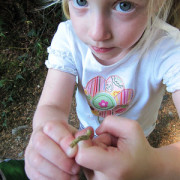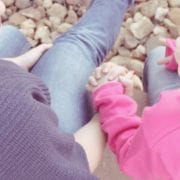A Faith That Builds
BY ERIC CLAYTON | April 29, 2021
I have bought more sets of Star Wars LEGOs since the pandemic began than I did throughout my entire childhood. I try to convince myself—and my wife—that it’s for our daughters. But my three-year-old doesn’t quite have the dexterity or patience to build even the simplest of sets, and my ten-month-old is still at the stage where she puts everything in her mouth.

So, what is it about these LEGO sets that have suddenly captured—or, recaptured—my imagination? My three-year-old and I do play with the finished sets; it’s only the building that foils her. She loves to make up scenarios in which Baby Yoda, a handful of Stormtroopers, and Rapunzel go to the park. (She did find a very small set of LEGOs based on Disney’s Tangled in her Easter basket.)
I love to see her mind at play. I see a lot of my own childhood imaginings reflected in her, in her approach to toys and stories and songs.
But why not get action figures, dolls, stuffed animals, things that can’t break into a million tiny pieces, things that aren’t choking hazards—and the bane of bare feet and vacuum cleaners?
I’ll be honest, when my daughter first took an interest in an old set I had, I was not pleased. It was a tank from Star Wars: Rogue One and we immediately lost a piece, some trigger firing off some tiny piece of plastic into the dark regions of our home. I shook an angry finger at my daughter: “We can’t lose pieces! You have to be careful! These break so easily!”
But as the pandemic has worn on and my collection has increased and I’ve found myself taking things apart and rearranging the build of ships and landscapes and all sorts of things, I realized that the fragility of these LEGO sets was exactly the reason I wasn’t buying action figures, dolls or stuffed animals—for me or my daughter.
If an action figure or doll breaks, that’s it. Bearing some hotshot with a glue stick, you now have multiple pieces of unusable plastic. You might be able to mix and match accessories, but you’re more or less stuck with what’s in the box, that image the packaging portrayed.
There’s something fluid about LEGOs. They break, pieces get lost and replaced and mixed up. But there’s always a chance to rebuild; there’s always a new purpose for the individual pieces—even if so many have been misplaced that you can no longer build what the image of the box prescribes. You can build something new, whatever you can imagine.
Isn’t this what we’re called to, now, in this moment, as we set our sights on our lives beyond the pandemic? Things are broken. Those images on our own boxes of life are no longer reflected in our present reality.
In the coming days and weeks and months, try not to reach for that glue stick. I think God has given us a whole bunch of LEGO pieces, and we’re being invited to imagine something new—and then commissioned to build it.
This piece was originally send as an email by the Jesuit Conference of Canada and U.S. as a part of a weekly series sharing tools and reflection resources in the tradition of Ignatian spirituality. Subscribe to receive these emails here!
Eric Clayton is the deputy communications director at the Jesuit Conference of Canada and the United States, responsible for developing and sharing resources and reflections to promote Ignatian spirituality. He is the author of the forthcoming book Cannonball Moments: Telling Your Story, Deepening Your Faith (Loyola Press). He and his wife are both graduates of Fairfield University and live in Baltimore, MD, with their two daughters. Follow his writing at ericclaytonwrites.com.









A faith that builds – is a nice thought-provoking piece. Thanks.
The story that Eric tells is one I experienced with my sons (now 34,36 and 38) and now my grandchildren 7 and under. In the first round of Legos, I watched the wonderful quiet of building structure after structure and what they created, there was something magical and mystical about each of the new structures. There was a sense of Sacred Space and the beauty of new life. Then my Legos collapsed as my son’s Dad died when they were young. It took me a long time to help them start building again. It was slow and laborious and not without many times of breaking all the buildings down and starting over. God was there with me and guided me.
When I watch the next generation, Eric’s story is very similar. The 2 grandsons, 2 granddaughters and baby like to play with the Legos already built as they are all under 7. When the Legos are thrown in frustration or anger, one sees the frustration of the larger society in dealing with our new world and figuring out what we need to remain focused on. The older ones sometimes begin to create their own structures in keeping with the joy and simplicity of living a Catholic life in union with God. They know that problems can be solved and issues can be thought about in a kinder and more inclusive way. And so hope blooms anew.